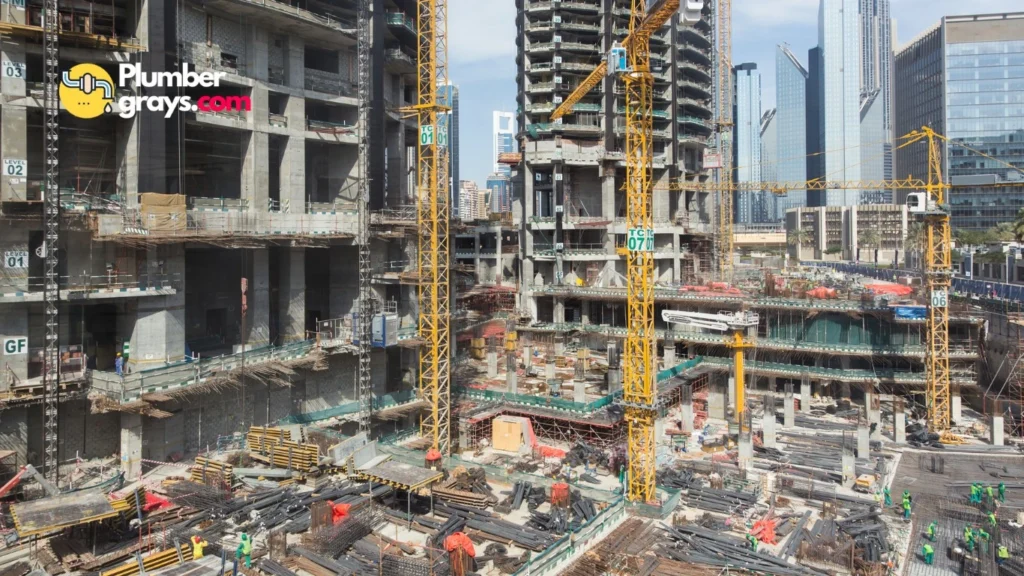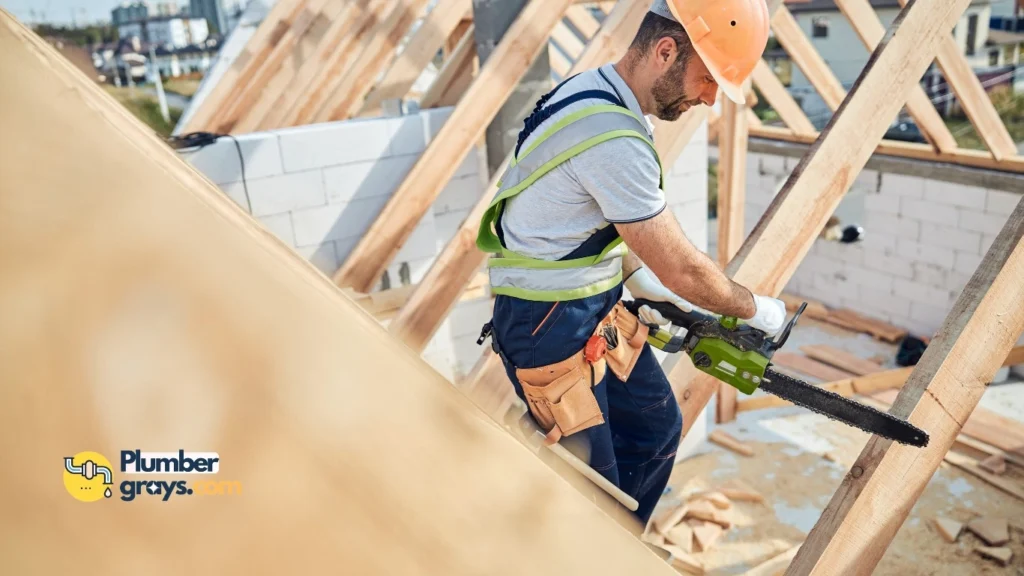Embarking on new construction plumbing introduces a critical framework to any building project, integrating the meticulous installation of piping, water, and sewer lines, along with essential fixtures. Adherence to local codes and obtaining the necessary permits are non-negotiable steps in this fundamental phase, pivotal for ensuring that homes equipped with plumbing construction remain functional for decades.
Drawing from my experience, I can attest to the intricate nature of plumbing systems, advising against DIY attempts due to the specialized expertise and technical skills required during the installation process. The subsequent sections will delve into the strategic stages of plumbing infrastructure, fixture selection, and the essential maintenance that accompanies plumbing new construction.,
Planning Your Plumbing Infrastructure
When planning your plumbing for new construction, it’s paramount to prioritize a design that not only complies with local codes but also optimizes functionality and efficiency. Here are key considerations to ensure a robust plumbing infrastructure that stands the test of time:
- Collaboration and Compliance:
- Engage with professionals to ensure your plumbing plan aligns with local regulations.
- Secure all necessary permits to avoid legal complications and ensure safety.
- Design and Material Selection:
- Centralize plumbing systems to simplify future repairs and maintenance.
- Choose high-quality materials to prevent leaks and extend system longevity.
- Consider installing a whole-house backwater valve to protect against sewage backups.
- Strategic Installation and Future Planning:
- Install main water shut-off valves in accessible locations for emergencies.
- Plan for additional connections to accommodate future water needs.
- Share a wet wall between bathrooms and kitchens to save on costs.
- Efficiency and Technology:
- Incorporate water-saving fixtures and appliances to minimize waste.
- Integrate technology for leak detection and smart water management.
- Outdoor Considerations:
- Account for seasonal changes and extreme weather when planning outdoor plumbing.
- To ensure your new home plumbing system functions flawlessly, proper drainage must be a top priority, especially in areas like the laundry room and any potential future outdoor spaces that may be added.
By meticulously considering these elements, you’ll craft a plumbing system that’s not only efficient and compliant but also primed for the evolving demands of plumbing new construction.
Installation Phases of New Construction Plumbing

The plumbing installation process for new construction is a critical component that unfolds through distinct stages, each meticulously designed to ensure a fully operational and code-compliant system. Here’s an insightful breakdown of each pivotal phase:
Excavation and Rough-In Phase
- Excavation: During the plumbing for new construction, trenches are expertly dug for water and sewer lines, with careful attention to proper depth and slope to guarantee optimal function and efficient drainage.
- Underground Piping: The layout and connection of main water supply and sewer lines, including the integration of underground drainage pipes, are essential for effective rainwater and stormwater management. This foundational work is a significant factor in the new construction plumbing cost.
Top Out Phase
- Drains and Water Lines: The internal network of the plumbing system is meticulously installed, encompassing drains, water lines, and vent pipes. This network is crucial for ensuring proper drainage and safeguarding against sewer gas entry, a key aspect of plumbing new construction.
- Fixture Placement: In the process of plumbing for new construction, bathtubs, showers, or shower bases are carefully positioned, setting the stage for their final connections and integration into the home’s plumbing infrastructure.
Read Also: Top Choices for Free Plumbing Estimates in Your Area
Trimming and Final Inspection Phase
- Fixture Installation: All plumbing fixtures, including sinks, showers, and toilets, as well as appliances such as dishwashers and washing machines, are expertly connected, marking a pivotal step in establishing the new home plumbing system.
- Testing: The entire plumbing system is subjected to thorough performance checks, which include leak detection, proper operation verification, and efficiency assessments to ensure a high standard of quality.
- Final Inspection: A meticulous inspection is conducted to confirm that the plumbing system complies with local building codes, an aspect that can influence the overall plumbing cost per square foot.
Throughout these stages, precision is paramount, from pinpointing connection locations to the installation of gas lines, ensuring that all components are securely in place. Quality control tests, part of plumbing and construction, are performed to resolve issues such as water pressure discrepancies and leaks, thereby guaranteeing the system’s durability and dependability.
Selecting the Right Plumbing Fixtures and Equipment
When tackling the plumbing cost for new house projects, selecting the right fixtures and equipment becomes a pivotal aspect of the construction process. Here’s what you need to weigh in on:
- Kitchen Plumbing Choices:
- Choose a sink, faucet, and finishes that align with your aesthetic preferences and meet your practical needs, keeping in mind the essentials of plumbing new construction.
- Ensure the finishes coordinate with other elements such as appliances and cabinet hardware.
- To make an informed decision for plumbing for new construction, consider visiting a local plumbing showroom to get a tangible sense of what will work best for your space.
- Bathroom and Laundry Selections:
- In primary bathrooms, it’s crucial to choose vanity sinks, faucets, toilets, and shower kits that elevate both functionality and design, reflecting the standards of new home plumbing.
- In kids’ baths, consider durability alongside style when choosing fixtures.
- Don’t neglect the laundry rooms and powder baths; opt for practical and robust options that align with the best practices in plumbing new construction for these essential areas.
- Budgeting and Style:
- Establish a realistic budget for the cost to plumb a house and stick to it, making selections based on price points and finishes such as brass, nickel, or chrome.
- Decide on a style that enhances the home’s overall aesthetic, whether modern, traditional, or industrial, as part of your comprehensive approach to plumbing new construction.
- When selecting finishes for your plumbing for new construction, mixing and matching can add distinct character, but it’s crucial to maintain consistency among water-related fixtures to achieve a cohesive look.
- Materials and Installation:
- Opt for high-quality materials like copper, stainless steel, and bronze in your fixtures to ensure longevity, a factor that can significantly impact your new construction plumbing cost per square foot.
- For installation areas, consider the fixture’s dimensions and design suitability.
- Professional installation is recommended to ensure proper function and to avoid common pitfalls [16].
- Purchasing Considerations:
- Be mindful that retail plumbing products may have plastic components, which could compromise their durability, unlike those sourced from wholesalers, which are often more robust and suitable for long-term plumbing repairs.
- Plumbing companies in Las Vegas often recommend wholesalers for their superior customer service, warranties, and extensive selection of high-quality plumbing options, setting them apart from retail alternatives.
While aesthetics are important, the functionality of your plumbing system should take precedence to avoid future issues. Verify that faucets are the correct scale and reach and that all fixtures have matching finishes to ensure a cohesive look, which is essential in managing new construction plumbing costs.
Maintaining Your New Plumbing System

To preserve the longevity of your new plumbing system and sidestep expensive plumbing maintenance down the line, it’s vital to adhere to recommended care practices to keep your plumbing performing optimally.
- Regular Cleaning and Clearing:
- Keep drains free of hair, food particles, soap, and grease to prevent clogs.
- Use a trash can in the bathroom to avoid flushing inappropriate items.
- Combat slow-running drains and sewer odors effectively with a drain snake or an enzymatic solution such as Bio-Clean, which can help maintain clear and odor-free pipes.
- Annual Inspections and Preventative Measures:
- To safeguard your home’s water integrity, it’s advisable to conduct yearly inspections of your pipes and engage in water line services to test local shut-off valves, ensuring they function without fault.
- Annual maintenance of your water heater is crucial; flush it to remove sediment and seek water heater services to replace the sacrificial anode as per the manufacturer’s recommended schedule.
- Be vigilant for signs of plumbing issues, such as leaks, unusual smells, drips, inconsistent water flow, or water damage, and seek prompt plumbing repairs to mitigate further complications.
- Professional Maintenance and Service:
- Partner with esteemed plumbing companies in Las Vegas, like Moe Plumbing Services, for professional expertise in the installation and meticulous maintenance of your plumbing systems.
- During regular maintenance, ensure plumbers conduct thorough performance checks, scrutinizing water pressure, potential leaks, and the overall operating system for optimal functionality.
- Leverage the warranties and 24-hour emergency plumbing services offered by Plumbing Solutions in Lexington to address any sudden plumbing issues with confidence and efficiency.
Adhering to these steps ensures the maintenance of an efficient plumbing system that not only provides comfort but also aids in saving on long-term costs. Quality assurance and consistent maintenance are as vital as the initial installation, so investing in professional services is key to maintaining your plumbing system, potentially reducing plumbing costs for a new house.
Conclusion
In this comprehensive guide, we’ve delved into the complexities of plumbing construction, highlighting the importance of strategic planning, strict adherence to building codes, and the necessity for professional installation. These elements combine to create a robust foundation for any structure, ensuring operational efficiency and long-lasting reliability. Choosing the right fixtures and a commitment to regular maintenance are key defenses against future plumbing issues, reflecting the forward-thinking that characterizes top-tier construction practices.
From blueprint to bathroom, the early decisions in residential and commercial plumbing lay the foundation for a system’s longevity and efficacy. Opting for resilient materials and integrating advanced smart water management technologies are critical for the sustainability and comfort of our habitats. To guarantee a seamless process from the initial design to the final inspection, it’s essential to rely on the expertise of seasoned professionals. Partner with Moe Plumbing Services for your new construction plumbing projects to meet the highest standards of quality, ensuring your property’s plumbing operates flawlessly for the foreseeable future.
FAQs
What is the average cost to install PEX plumbing in a house?
When considering how much plumbing costs for a new house, the average investment for PEX plumbing installation falls between $4,200 and $6,000. The total expense for repiping a residence with PEX can span a broad range, from about $1,500 to over $15,000, influenced by the home’s size, the intricacies of the project, and the prevailing local labor costs.
Inquiring about how much does plumbing costs for extending a water line by 1000 feet.
The answer varies based on several factors, including the terrain and the materials selected for the project.
The cost to plumb a new house, specifically for extending a water line by 1000 feet, can fluctuate significantly. Utilizing trenchless techniques for water main replacement, a prevalent choice for both residential and commercial applications, the average expenditure ranges from $75 to $150 per linear foot.
What elements should be included in a plumbing estimate?
A comprehensive plumbing estimate should outline the following details:
- The scope of the work to be done
- A list of materials required
- The projected timeline for completion
- Labor costs
- Costs of materials
- Applicable taxes
- Any additional fees that may be incurred
Moreover, it’s prudent to include a plumbing cost estimate disclaimer with any financial projection, clarifying that the provided figures are preliminary estimates and that the actual costs may ultimately vary.
Can you explain what ‘roughed in’ plumbing means?
The term ‘rough in plumbing cost’ pertains to the initial phase of plumbing in new construction, where basic components like vents, sewer lines, and water connections are installed. This crucial stage lays the groundwork for the ‘finish plumbing’ phase, which involves completing installations and making the necessary connections to ensure the dwelling is ready for occupancy.


Comments are closed